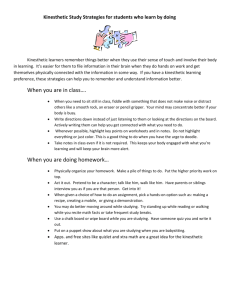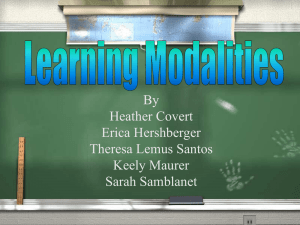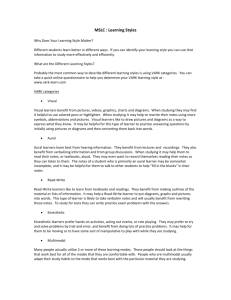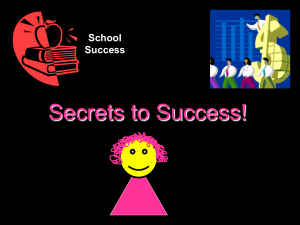High School Survival Guide
advertisement
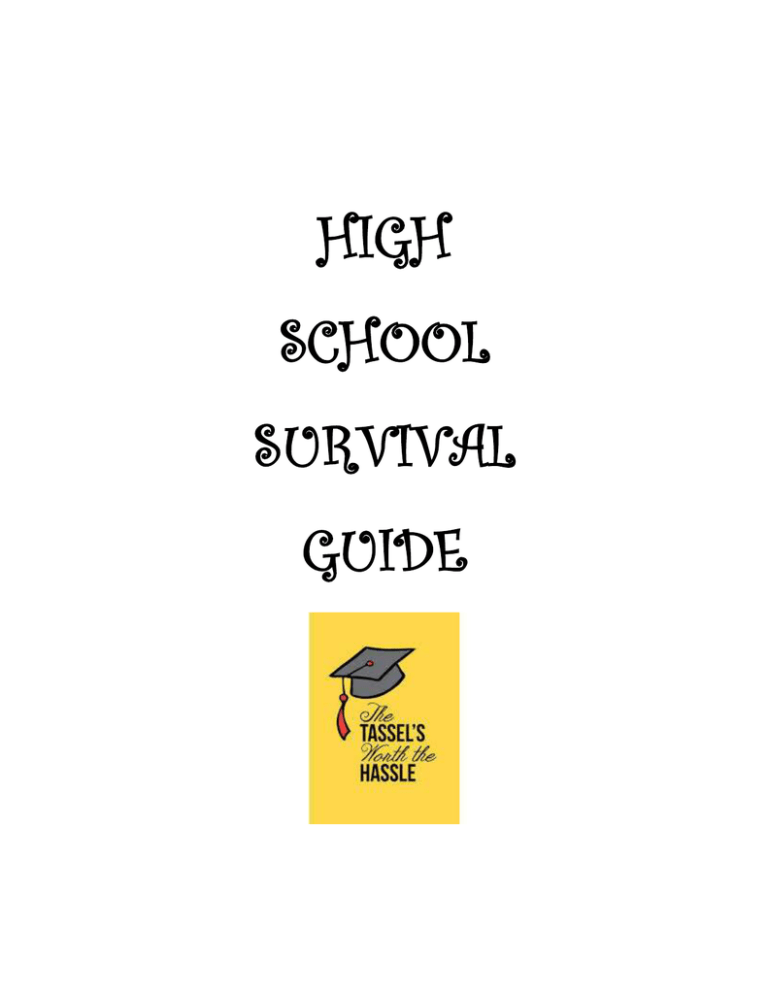
HIGH SCHOOL SURVIVAL GUIDE Learning Style Inventory A simple explanation of learning styles is this: some students remember best materials they've seen, some remember things they've heard, while others remember things they've experienced. To better understand how you prefer to learn and process information, circle often, sometimes or seldom after each statement below, then use the scoring directions on the next page to evaluate your responses. Use what you learn from your scores to better develop learning strategies that are best suited to your particular learning style. Respond to each statement as honestly as you can. 1. I can remember best about a subject by listening to a lecture that includes information, explanations and discussions. Often Sometimes Seldom 2. I prefer to see information written on a chalkboard and supplemented by visual aids and assigned readings. Often Sometimes Seldom 3. I like to write things down or to take notes for visual review. Often Sometimes Seldom 4. I prefer to use posters, models, or actual practice and other activities in class. Often Sometimes Seldom 5. I require explanations of diagrams, graphs, or visual directions. Often Sometimes Seldom 6. I enjoy working with my hands or making things. Often Sometimes Seldom 7. I am skillful with and enjoy developing and making graphs and charts. Often Sometimes Seldom 8. I can tell if sounds match when presented with pairs of sounds. Often Sometimes Seldom 9. I can remember best by writing things down. Often Sometimes Seldom 10. I can easily understand and follow directions on a map. Often Sometimes Seldom 11. I do best in academic subjects by listening to lectures and tapes. Often Sometimes Seldom 12. I play with coins or keys in my pocket. Often Sometimes Seldom 13. I learn to spell better by repeating words out loud than by writing the words on paper. Often Sometimes Seldom 14. I can understand a news article better by reading about it in a newspaper than by listening to a report about it on the radio. Often Sometimes Seldom 15. I chew gum, smoke or snack while studying. Often Sometimes Seldom 16. I think the best way to remember something is to picture it in your head. Often Sometimes Seldom 17. I learn the spelling of words by “finger spelling” them. Often Sometimes Seldom 18. I would rather listen to a good lecture or speech than read about the same material in a textbook. Often Sometimes Seldom 19. I am good at working and solving jigsaw puzzles and mazes. Often Sometimes Seldom 20. I grip objects in my hands during learning periods. Often Sometimes Seldom 21. I prefer listening to the news on the radio rather than reading the paper. Often Sometimes Seldom 22. I prefer obtaining information about an interesting subject by reading about it. Often Sometimes Seldom 23. I feel very comfortable touching others, hugging, handshaking, etc. Often Sometimes Seldom 24. I follow oral directions better than written ones. Often Sometimes Seldom Scoring Procedures Directions: Place the point value on the line next to the corresponding item below. Add the points in each column to obtain the preference score under each heading. Often = 5 points Visual Number Points 2 3 7 10 14 16 19 22 VPS = Visual Preference Score Sometimes = 3 points Seldom = 1 point Auditory Tactile Number Points Number Points 1 4 5 6 8 9 11 12 13 15 18 17 21 20 24 23 APS = TPS = Auditory Preference Tactile Preference Score Score My highest score was the ___________________Preference My second highest was the __________________Preference My weakest area was the ___________________Preference Learning Styles Assessment Read each statement and select the appropriate number response as it applies to you. Often (3) Visual Modality Sometimes (2) Seldom/Never (1) ______ I remember information better if I write it down. ______ Looking at the person helps keep me focused. ______ I need a quiet place to get my work done. ______ When I take a test, I can see the textbook page in my head. ______ I need to write down directions, not just take them verbally. ______ Music or background noise distracts my attention from the task at hand. ______ I don’t always get the meaning of a joke. ______ I doodle and draw pictures on the margins of my notebook pages. ______ I have trouble following lectures. ______ I react very strongly to colors. ______ Total Auditory Modality ______ My papers and notebooks always seem messy. ______ When I read, I need to use my index finger to track my place on the line. ______ I do not follow written directions well. ______ If I hear something, I will remember it. ______ Writing has always been difficult for me. ______ I often misread words from the text-(i.e., “them” for “then”). ______ I would rather listen and learn than read and learn. ______ I’m not very good at interpreting an individual’s body language. ______ Pages with small print or poor quality copies are difficult for me to read. ______ My eyes tire quickly, even though my vision check-up is always fine. ______ Total Kinesthetic/Tactile Modality ______ I start a project before reading the directions. ______ I hate to sit at a desk for long periods of time. ______ I prefer first to see something done and then to do it myself. ______ I use the trial and error approach to problem-solving. ______ I like to read my textbook while riding an exercise bike. ______ I take frequent study breaks. ______ I have a difficult time giving step-by-step instructions. ______ I enjoy sports and do well at several different types of sports. ______ I use my hands when describing things. ______ I have to rewrite or type my class notes to reinforce the material. ______ Total Total the score for each section. A score of 21 points or more in a modality indicates strength in that area. The highest of the 3 scores indicates the most efficient method of information intake. The second highest score indicates the modality which boosts the primary strength. For example, a score of 23 in visual modality indicates a strong visual learner Your dominant learning style is: ________________________ Second most dominant learning style: ____________________ Weakest learning modality: ______________________ Characteristics of Learning Styles Three of your senses are primarily used in learning, storing, remembering and recalling information. Your eyes, ears, and sense of touch play essential roles in the way you communicate, perceive reality and relate to others. Because you learn from and communicate best with someone who shares your dominant modality, it is a great advantage for you to know the characteristics of visual, auditory and kinesthetic styles and to be able to identify them in others. Visual · Mind sometimes strays during verbal activities · Observe rather than acts or talks · Likes to read · Usually a good speller · Memorizes by seeing graphics or pictures · Not too distractible · Finds verbal instruction difficult · Has good handwriting · Remembers faces · Uses advanced planning · Doodles · Quiet by nature · Meticulous, neat in appearance · Notices details Auditory · Talks to self aloud · Enjoys talking · Easily distracted · Has difficulty with written directions · Likes to be read to · Memorizes sequentially · Enjoys music · Whispers to self while reading · Distracted by noise · Hums or sings · Outgoing by nature · Enjoys listening activities Kinesthetic · Likes physical rewards · In motion most of the time · Likes to touch people when talking · Taps pencil or foot when studying · Enjoys doing activities · Reading not a priority · Poor speller · Likes to solve problems by physically working through them · Will try new things · Outgoing by nature; expresses emotions by physical means · Uses hands while talking · Dresses for comfort Visual Learner Characteristics Visual learners are those who learn through seeing things. Visual learners have a preference for seeing material in order to learn it. A visual learner: Is good at spelling but forgets names. Needs quiet study time. Has to think awhile before understanding lecture. Is good at spelling. Likes colors & fashion. Dreams in color. Understands/likes charts. Is good with sign language. Learning Suggestions for Visual Learners Draw a map of events in history or draw scientific process. Make outlines of everything! Copy what's on the board. Ask the teacher to diagram. Diagram sentences! Take notes, make lists. Watch videos. Color code words, Outline reading. Use flashcards. Use highlighters, circle words, underline. Strengths of the visual learner: Instinctively follows directions, can easily visualize objects, has a great sense of balance and alignment, is an excellent organizer Best ways to learn: Studying notes on overhead slides, reading diagrams and handouts, following a PowerPoint presentation, reading from a textbook, studying alone Best Test Type for Visual Learners: Diagramming, reading maps, essays (if you've studied using an outline), showing a process Worst test type: Listen and respond tests Auditory Learner Characteristics Auditory learners are those who learn best through hearing things. Look over these traits to see if they sound familiar to you. An auditory learner: Likes to read to self out loud. Is not afraid to speak in class. Likes oral reports. Is good at explaining. Remembers names. Notices sound effects in movies. Enjoys music. Is good at grammar and foreign language. Reads slowly. Follows spoken directions well. Can't keep quiet for long periods. Enjoys acting, being on stage. Is good in study groups. Auditory Learners Can Benefit from: Using word association to remember facts and lines. Recording lectures. Watching videos. Repeating facts with eyes closed. Participating in group discussions. Using audiotapes for language practice. Taping notes after writing them. Strengths of Auditory Learning: Auditory learners may have trouble reading silently and responding in a quiet classroom. Those with an auditory learning style like to speak and hear others speak in order to learn best. Here are some other strengths of this learning type: Great at explaining ideas Understanding subtle changes in tone in a person's voice Writing responses to lectures Oral exams Story-telling Solving difficult problems Working in groups Participating in class discussions Listening to directions Auditory Learning Strategies for Students Best test type: Auditory Learners are good at writing responses to lectures they've heard. They're also good at oral exams. Worst test type: Reading passages and writing answers about them in a timed test. Play classical music in the background when studying Study in groups or with another person by having people ask you questions aloud. Read assignments out loud Ask your teacher if you can record lectures to listen to later Participate in class discussions as much as possible. Sit near the front of the room so you can hear Learn facts by recitation Kinesthetic Learner Characteristics Kinesthetic learners are those who learn through experiencing/doing things. Look over these traits to see if they sound familiar to you. A kinesthetic learner: Is good at sports. Can't sit still for long. Is not great at spelling. Does not have great handwriting. Likes science lab. Studies with loud music on. Likes adventure books, movies. Likes role playing. Takes breaks when studying. Builds models. Is involved in martial arts, dance. Is fidgety during lectures. Kinesthetic Learners Can Benefit from: Studying in short blocks. Taking lab classes. Role playing. Taking field trips, visiting museums. Studying with others. Using memory games. Using flash cards to memorize. Best Test Type: Strengths of Kinesthetic Learning Kinesthetic learners have many strengths that can help them achieve success in the classroom if the teacher can focus their attention appropriately. Great hand-eye coordination Quick reactions Excellent motor memory (can duplicate something after doing it once) Excellent experimenters Good at sports Performs well in art and drama High levels of energy Kinesthetic Learning Strategies for Students Short definitions, fill-ins, multiple choice. Worst Test Type: Long tests, essays. Stand up when you're feeling your mind start to wander. If you're in high school or middle school, ask the teacher first before so you're not labeled as disruptive. Bring a rubber band to class and wrap and unwrap it around your hand or pencil. When studying, bounce a tennis ball against the wall or floor when you're answering questions. Underline, highlight or make notes while you read. Using efficient reading strategies will help you stay focused. Tense and relax your muscles during long lectures. Bounce a leg up and down to release some of the energy Your learning style can be helpful in improving your grades. Students learn in many ways, like seeing, hearing, and experiencing things first hand. But for most students, one of these methods stands out. Why is this important? Research has shown that students can perform better on tests if they change study habits to fit their own personal learning styles. Hints for the Auditory Learner General 1. Say aloud the information to be learned/have someone read the information to you/read it into a recorder and replay it. 2. Read your work out loud. Summarize what you have read on a recorder. 3. Say words inside your head silently. 4. Brainstorm ideas with others. Form study groups. 5. When possible, learn information through tapes, television, oral reports, rhymes and songs, radio, lectures, book reviews, panel and group discussions, guest lectures, and oral questions and answers. 6. Use a straight-edge marker or guide to assist you in keeping your place while you are reading or working with printed materials. 7. Record class lectures (Ask instructor for permission). 8. Meet with classmates before and/or after class to discuss material. Writing 1. Plan each sentence you want to write by saying it out loud or silently in your head. 2. Say each sentence several times. 3. Write each sentence as you say it, or talk into a tape recorder, dictating each sentence of your paragraph; then play the tape back – one sentence at a time – and record your paragraph in writing. Spelling 1. Listen to the spelling of the word. 2. Say the word – then say each letter out loud. 3. Close your eyes and spell the word out loud; check your spelling. 4. Close your eyes and spell the word out loud again; check your spelling. 5. Now write the word, trying to hear it in your mind. 6. Verbally review spelling words and lectures with a friend. Mathematics 1. Learn math while saying the concept, fact, theorem, etc., aloud. 2. Explain math problems, concepts, facts, etc., to yourself, relating the information out loud. 3. Use a recorder and replay the information. Hints for the Visual Learner General 1. Take notes; make pictures, graphs, and charts. Use flashcards and highlight key details 2. Sit close to the teacher so that you can watch his /her face and gestures. 3. Take notes or make lists as you listen to directions. 4. Carefully check instructions written on the chalkboard and on handouts. 5. As the teacher lectures, pay attention to visual aids such as the following: - Drawing, maps, graphs, charts - Transparencies, posters, films, books 6. Imagine pictures of the information you are suppose to remember. 7. Use color coding as cues to important information. 8. When possible, read assignments silently. 9. Maintain class notes and outlines of important information to study. 10. Try to read and study in well lit, quiet place. 11. Record homework assignments in a date book, on a note pad, or a specially designed assignment sheet. 12. Keep a note pad with you at all times. Write out everything for frequent and quick visual review. Reading 1. Use sight words, flashcards, note cards and experience stories; don’t try to sound words out, but try to determine if the new word or words has words you already know. For example, the “systematic” has the word “system”, “stem” and “mat” within it. 2. You are a “look-and-say” learner. Look at a word carefully; then say it. Writing 1. Jot down ideas as they form in your mind. 2. Outline your ideas. 3. Make a rough draft, skipping lines. Correct/revise your work. 4. Re-copy your paper. 5. ESSAY TEST: Make quick outlines on scratch paper or in the margin of the test before writing your answer. Spelling 1. See the word – close your eyes. 2. Make a picture – then read from your picture. 3. Write the word – match the picture. 4. Check your work immediately. Mathematics 1. Visualize the problem. 2. Make pictures or tallies of the problem on scratch paper. 3. Write the problem. Hints for the Tactile/Kinesthetic Learner 1. Keep your desk clear of distracting objects. 2. Cover the page you’re not reading. 3. If you are distracted by noise, turn off the radio; wear earplugs or wear earphones to block out the noise. If you want sound, listen to soft music without lyrics. 4. Divide your work into short study sessions. Get a timer. After 20 minutes or when a task is completed, give yourself a reward, a cookie, a walk around the block; listen to one song, etc. 5. Sit as close to the teacher as possible, or sit in the center of the room by quiet students. 6. When studying, use a multi-sensory approach (hearing, seeing, touching and doing) as much as possible. 7. Get plenty of sleep. 8. Eat a nutritious breakfast and lunch. Snack on fruit or nutritious food if you need extra energy. 9. Study in an enclosed or in an office where there is a desk for your text books and notebook. 10. Use models, real objects, and materials that can be touched and moved. For example, learn geography through handling and studying a globe. 11. When possible draw what you are learning. 12. Trace spelling words as you practice them. 13. Record in writing information learned. Keep a supply of paper on hand. 14. When possible, role play, type, take notes, or construct models to learn the information. 15. Bounce a ball as you read; trace words or numbers in the air while they study. 16. Using a computer to reinforce learning through the touch of a keyboard can help active learners. 17. Chew gum 18. Take frequent study breaks to move around. 19. Read on an exercise bike 20. Conduct experiments or act out word problems I Know My Learning Style! How Do I Best Prepare For A Test? If you are a visual learner: If your preferred style of learning is visual, then you can use pictures, diagrams, charts and other visual images to learn better. You can improve your learning skills by incorporating your imagination and visualization, because this comes effortlessly to you. As you have strong sense for colors, you can use several colors to highlight the key points in your lessons. You can use mind maps and pictures instead of just reading the text. If you are not able to use the computer, you can make use of color pens and markers to remember important points with ease. The story technique can aid you in memorizing large contents. You can use systems diagrams to visualize the links between the components of the system. You can boost your concentration skills by using layouts and charts. If you are an auditory learner: Ask questions! All auditory learners should aim to ask questions during a lesson. Even a simple question will greatly increase information retention. This way, their teacher will put an idea into words, or paraphrase what they’ve been saying. Auditory learners could benefit from taping their notes once they’ve written them. This will force them to say out loud what they’ve just learnt in a way that makes sense to them – cementing it into their head. They can also use the spoken notes to study later. If you are a tactile or kinesthetic learner: Use flash cards! Flash cards make kinesthetic learners turn simple recall into a game. This makes them perfect for kinesthetic learners. Simply write a question or topic suggestion on one side of a card, and the answer or a list of details they should remember on the other side. The beauty of flash cards is that you can use them by yourself or with others. Study in short blocks. Kinesthetic learners tend to have a relatively short attention span when they’re studying. But this doesn’t mean they shouldn’t be doing just as much studying as everyone else. They should break their study up into shorter periods, but also take shorter breaks. Study with other people. Kinesthetic learners enjoy discussion. Talking about what they’ve learned is often a great way to consolidate what they’ve learned. Do something while you study. Tap a pencil, squeeze a stress ball, or do something to occupy the want to do something with their hands without becoming a distraction. 10 Great Study Habits It is never too late to develop great study habits. If you're starting a new school year, or you just want to improve your grades and school performance, take a look at this list of good habits and start making some changes in your routine. 1. Write Down Every Assignment The most logical place to write down your assignments is in a planner, but you might prefer to keep a todo list in a simple notebook or in your cell phone note pad. It doesn't really matter what tool you use, but it is absolutely essential to your success to write down every single assignment, due date, test date, and task. Who can afford to score a big fat "0" on a paper, just because we got lazy and didn't pay attention to the due date? Who wants to get an "F" because we forgot to put our completed project in our book bag the night before it was due? Poor organization skills can reduce your final scores by a whole letter grade. That's why you should learn to use a day planner the right way. 2. Remember to Bring Your Homework to School It sounds simple enough, but many F's come from students forgetting to bring a perfectly good paper to school with them. Does your homework have a home? Is there a special place where you always put your paperwork each night? To avoid forgetting your homework, you must establish a strong homework routine with a special homework station where you work each night. Then you must get in the habit of putting your homework where it belongs right after you finish it, whether this is in a special folder on your desk or in your backpack. 3. Communicate With Your Teacher Every successful relationship is built upon clear communication. A student-teacher relationship is no different. Miscommunication is another one of those factors that can cause bad grades, despite good efforts on your part. At the end of the day, make sure you understand every assignment that's expected of you. Imagine getting a bad grade on a 5-page paper because you didn't understand the difference between an expository essay and a personal essay. Be sure to ask questions and find out what format you should use when you write a paper or what type of questions might appear on your history exam. The more questions you ask, the more prepared you'll be. 4. Organize With Color Devise your own color-coding system to keep your assignments and your thoughts organized. You may select a single color for each class (like science or history) and use that color for your folder, your highlighters, your sticky notes, and your pens. You'll be surprised to discover how much strong organization skills can change your life! Color-coding is also a tool to use when conducting research. For example, you should always keep several colors of sticky flags on hand when you're reading a book for school. Assign a specific color the every topic of interest. Place a flag on a page containing information you will need to study or to cite. It works like magic! 5. Establish a Study Zone at Home Take the time to assess your individual style and your real needs and plan for the perfect study place. After all, if you can’t concentrate, you certainly can’t expect to learn very well. Students are different. Some need a completely quiet room free from interruptions when they study, but others actually study better listening to quiet music in the background or taking several breaks. Find a place to study that fits your specific personality and learning style. Then stock your study space with school supplies that will help you avoid last-minute emergencies. 6. Prepare Yourself for Test Days You know that it's important to study for test days, right? But there are other things you should consider in addition to the actual material that the test will cover. What if you show up for test day and the room is freezing cold? For many students, this would cause enough of a distraction to interrupt concentration. That leads to bad choices and bad answers. Plan ahead for heat or cold by layering your clothing. And what happens when you spend so much time on one essay question that you don't have enough time to finish the exam? Another way to prepare for test day is to take a watch and be mindful of time management. 7. Know Your Dominant Learning Style Many students will struggle in a subject without understanding why. Sometimes this is because students don't understand how to study in a way that matches their brain style. Auditory learners are those who learn best through hearing things. Visual learners retain more information when they use visual aids, and tactile (kinesthetic) learners benefit by doing hands-on projects. Every student should examine and evaluate their habits and their natural tendencies and decide how they might be able to improve their study habits by tapping into their personal strengths. 8. Take Fabulous Notes There are a few tricks to taking fabulous notes that really help when it comes to studying. If you’re visual person, you should make as many doodles on your paper as you can. Useful doodles, that is. As soon as you realize that once topic relates to another, comes before another, is the opposite of another, or has any kind of connection to another—draw a picture that makes sense to you. Sometimes the information will not sink in until and unless you see it in an image. There are also certain code words to look out for in a lecture that can indicate that your teacher is giving you the relevance or the context of an event. Learn to recognize key words and phrases that your teacher deems important. 9. Conquer Procrastination When you put things off a lot, you end up putting things off until it's too late from time to time. It's that simple. When you procrastinate, you take the chance that nothing will go wrong at the last minute--but in the real world, things do go wrong. So how can you battle the urge to put things off? Start with trying to recognize that a feisty little voice that lives inside every one of us. It tells us it would be more fun to play a game, eat, or watch TV when we know better. Don’t fall for it! 10. Take Care of Yourself Some of your personal habits might be affecting your grades. Are you feeling tired, achy, or bored when it comes to homework time? You can change your grades by practicing a few healthy habits. Change the way you feel by taking better care of your mind and your body. Getting enough sleep, exercising and eating well can really improve how you feel. 10 Habits of High Effective Students Some people believe that really successful students are just born that way. True, some students are able to breeze through school with little or no effort. However, the vast majority of successful students achieve their success by developing and applying effective study habits. The following are the top 10 study habits employed by highly successful students. So if you want to become a successful student, don't get discouraged, don't give up, just work to develop each of the study habits below and you're see your grades go up, your knowledge increase and your ability to learn and assimilate information improve. 1. Don't try cram all your studying into one session. Successful students typically space their work out over shorter periods of time and rarely try to cram all of their studying into just one or two sessions. If you want to become a successful student then you need to learn to be consistent in your studies and to have regular, yet shorter, study periods. 2. Plan when you're going to study. Successful students schedule specific times throughout the week when they are going to complete their studying -- and then they stick with their schedule. Students who study sporadically and whimsically typically do not perform as well as students who have a set study schedule. 3. Study at the same time. Not only is it important that you plan when you're going to study but that you also create a consistent, daily study routine. When you study at the same time each day and each week you're studying will become a regular part of your life. You'll be mentally and emotionally more prepared for each study session and each study session will become more productive. 4. Each study time should have a specific goal. Simply studying without direction is not effective. You need to know exactly what you need to accomplish during each study session. Before you start studying set a study session goal that supports your overall academic goal (i.e. memorize 30 vocabulary words in order to ace the vocabulary section on an upcoming Spanish test.) 5. Never procrastinate your planned study session. It’s very easy, and common, to put off your study session because of lack of interest in the subject, because you have other things you need to get done first or just because the assignment is hard. Successful students DO NOT procrastinate studying. If you procrastinate your study session, your studying will become much less effective and you may not get everything accomplished that you need to. Procrastination also leads to rushing, and rushing is the number one cause of errors. 6. Start with the most difficult subject first. As your most difficult assignment or subject will require the most effort and mental energy you should start with it first. Once you've completed the most difficult work it will be much easy to complete the rest of your work. Believe it or not, starting with the most difficult work will greatly improve the effectiveness of your study sessions and your academic performance. 7. Always review your notes before starting an assignment. Obviously, before you can review your notes you must first have notes. Always make sure to take good notes in class. Before you start each study session and before you start a particular assignment review your notes thoroughly to make sure you know how to complete the assignment correctly. 8. Make sure you're not disturbed whiles you're studying When you're disturbed while you're studying you (1) lose your train of thought and (2) you get distracted -- both of which will lead to very ineffective studying. Before you start studying find a place where you won't be disturbed. 9. Use study groups effectively Have you ever heard the phrase "two heads are better than one"? Well this can be especially true when it comes to studying. Working in groups enables you to (1) get help from other students when you're struggling to understand a concept, (2) complete assignments more quickly, and (3) teach others whereby helping both the other student and yourself to internalize the subject matter. However, study groups can become very ineffective if they're not structured and if groups members come unprepared. Effective students use study groups effectively. 10. Review your notes, schoolwork and other class materials over the weekend. Successful students review what they've learned during the week. This way students are well prepared to continue learning new concepts at the beginning of each week that build upon coursework and knowledge acquired the previous week. We're confident that if you'll develop the habits outlined above that you'll see a major improvement in your academic success.
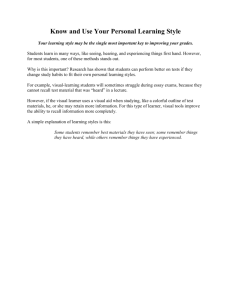
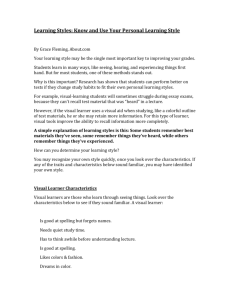
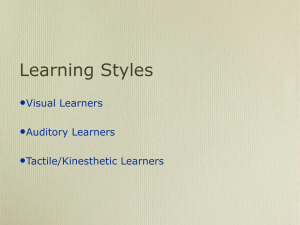
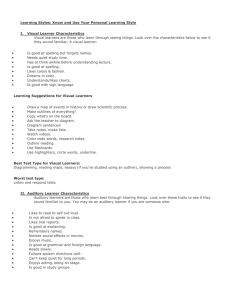

![to Learning Styles Questionnaire [MS Word,93Kb]](http://s3.studylib.net/store/data/007287401_2-741c6340dee171d22423967f2d0c2716-300x300.png)
